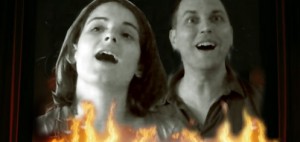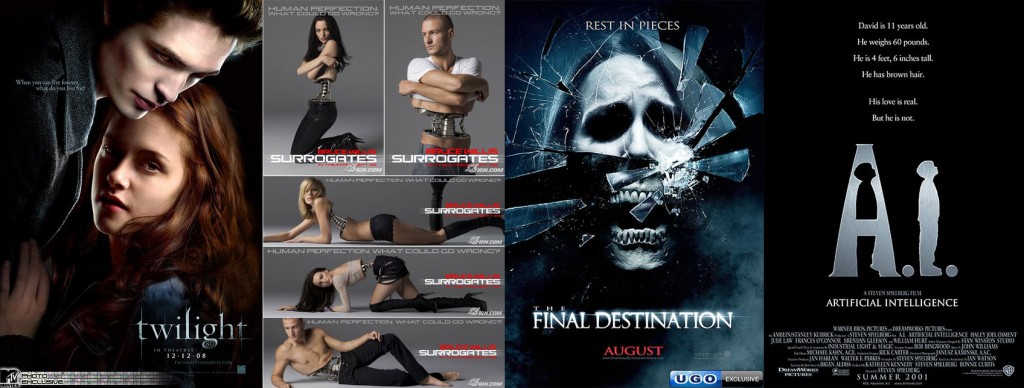Links Roundup: More Basterds
 The Film Experience: Vodcast with the talking heads of Nat Rogers and Katey Rich on Inglourious Basterds. Also: Nat’s 25 fave actors mini-blogathon
The Film Experience: Vodcast with the talking heads of Nat Rogers and Katey Rich on Inglourious Basterds. Also: Nat’s 25 fave actors mini-blogathon
Cinephilia: Hilariously mean skit of Brad Pitt getting the phone call for his role in Basterds (with well-observed sideswipes at Angelina Jolie and Tim Burton).
Scanners: Jim Emerson reviews Basterds through the lenses of its auteur Quentin Tarantino’s perspectives on story, character, emotion, dialogue and the movies. He also directs us to a Village Voice interview with Quentin (thx).
Sergio Leone and the Infield Fly Rule: A massive conversation on Basterds. Continued in parts two, three and four
Slog posts a wry, understated theatre marquee for Basterds. “Understated” because, well, it’s almost a truism (thx):

The Film Doctor: Insightful 14-point analysis of Basterds
Antagony & Ecstasy: Tim Brayton backs up the theory that Basterds is a movie about WWII movies:
A direct riposte to the predictable howls of outrage from people wondering when the hell Tarantino is going to grow up and start addressing the real world, anyway, the film as much as argues, “what movie was ever about the real world? And with that in mind, why can’t I just go balls-out crazy?” Besides, he already demonstrated in Pulp Fiction that movies and television have replaced the real world as our model for reality; to call something “real” actually means that it’s reminiscent of “realist” films.
Spinning off Basterds‘ historically inaccurate conceit, Tim further lists ten good movies that make for bad history lessons. He also highlights the screenwriting pleasures of 1983 slasher flick Sleepaway Camp
Meanwhile, Quentin Tarantino praises fellow auteur Paul Thomas Anderson’s There Will Be Blood, comparing their mutual inspirations to Marlon Brando and Montgomery Clift’s (thx):
Other “Basterds”…
Classic film actress Lauren Bacall delivers a Twitter smackdown on Twilight (thx):
Yes, I saw Twilight – my granddaughter made me watch it, she said it was the greatest vampire film ever. After the “film” was over I wanted to smack her across her head with my shoe, but I did not want a book called Grannie Dearest written on me when I die. So instead I gave her a DVD of Murnau’s 1922 masterpiece Nosferatu and told her, “Now that’s a vampire film!” And that goes for all of you! Watch Nosferatu instead!

Sergio Leone and the Infield Fly Rule rants about the unoriginal marketing and premise of “scifi thriller” Surrogates, contrasting it with 1973’s Westworld
The New York Times expounds on the easy pleasures of the Final Destination movies, ending up comparing them to Bergman:
Their first innovation is the casting of Death itself as the antagonist, which turns out to be quite pleasing from a design perspective. These are remarkably streamlined, clutter-free movies, unencumbered by the need to identify the killer or his motivation, let alone explain why he appears to die at the end of one film only to be revived at the start of the next. There is no supernatural or psychological back story and — a rarity in this most charged of genres —no sociopolitical subtext to speak of. At most, for those so inclined, the movies function as memento mori, posing cosmic questions about fate and mortality. The arc of any “Final Destination” film — a futile, movielong negotiation with Death — echoes that of the Bergman classic “The Seventh Seal.”
Shooting Down Pictures: Liveblog of Steven Spielberg’s A.I. Artificial Intelligence
The Auteurs: Panel discussion on the future of movie criticism in the blog-and-Twitter era. On a more optimistic note, Film Studies for Free offers an extensive collection of free online scholarship on movie criticism.
…and Blogathons
Live Tweets du #Cinema is holding a live-tweet on Orson Welles’ The Batman on Sept 5, 6pm – 7:30pm PST
The House Next Door is holding a week-long blogathon on Pixar on Oct 4-10, 2009. Can’t wait




